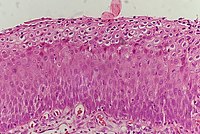Cervical intraepithelial neoplasia
Generally, signs and symptoms of cervical cancer include:[7] HPV infection of the vulva and vagina can cause genital warts or be asymptomatic.[10] Of the over 100 different types of HPV, approximately 40 are known to affect the epithelial tissue of the anogenital area and have different probabilities of causing malignant changes.Endocervical brush sampling at the time of Pap smear to detect adenocarcinoma and its precursors is necessary along with doctor/patient vigilance on abdominal symptoms associated with uterine and ovarian carcinoma.[citation needed] CIN is classified in grades:[14] The College of American Pathologists and the American Society of Colposcopy and Cervical Pathology came together in 2012 to publish changes in terminology to describe HPV-associated squamous lesions of the anogenital tract as LSIL or HSIL as follows below:[16] CIN 1 is referred to as LSIL.Frequency of screening changes based on guidelines from the Society of Lower Genital Tract Disorders (ASCCP).[citation needed] HPV vaccination is the approach to primary prevention of both CIN and cervical cancer.Appropriate management with monitoring and treatment is the approach to secondary prevention of cervical cancer in cases of persons with CIN.[6] The typical threshold for treatment is CIN 2+, although a more restrained approach may be taken for young persons and pregnant women.[24][25] Surgical techniques that remove more cervical tissue come with less risk of the cancer recurring but a higher chance of giving birth prematurely.Due to this risk, taking into account the age, childbearing plans of the woman, the size and location of the cancer cells are crucial for choosing the right procedure.Research to investigate if prophylactic antibiotics can help prevent infection in women undergoing excision of the cervical transformation zone found a lack of quality evidence.[27] People with HIV and CIN 2+ should be initially managed according to the recommendations for the general population according to the 2012 updated ASCCP consensus guidelines.






acetic acidSpecialtyGynecologycervixcervical cancerprecanceroussquamocolumnar junctionsquamous epitheliumendocervixintraepithelial neoplasiasimmune systemgenital wartstumor suppressor genesImmunodeficiencyepithelial dysplasiatransformation zonekoilocytestissueanogenitalPap smearcolposcopyuterineovarian carcinomahistologicalBethesda System for Reporting Cervical/Vaginal Cytologic Diagnosessquamous intraepithelial lesioncarcinoma in situclock facesupine positionCollege of American PathologistsCervical screeningbiopsyWorld Health OrganizationHPV vaccineprimary preventionsecondary preventioncryocauteryelectrocauterylaser cauteryloop electrical excision procedurecervical conizationpremature birthvaccinesintraepithelial neoplasiasecond trimesterFood and Drug AdministrationAmerican Congress of Obstetricians and GynecologistsChoosing WiselyABIM FoundationMedlinePlusRelateddiseasescancersVaginalVulvarPenileHead and neck cancerHPV-positive oropharyngeal cancergenitalplantarLaryngeal papillomatosisEpidermodysplasia verruciformisFocal epithelial hyperplasiaPapillomaskin tagsVaccineHPV vaccinesCervarixGardasilScreeningPap testBethesda systemCytopathologyCytotechnologySpeculoscopyCervicographyhistologyKoilocyte Vaginal intraepithelial neoplasia (VAIN) Vulvar intraepithelial neoplasia (VIN)Loop electrical excision procedure (LEEP)Georgios PapanikolaouHarald zur HausenTumorsurogenital systemAdnexaOvariessurface epithelial-stromal tumorOvarian serous cystadenomaMucinous cystadenomaCystadenocarcinomaPapillary serous cystadenocarcinomaKrukenberg tumorEndometrioid tumorOvarian clear-cell carcinomaBrenner tumourSex cord–gonadal stromalLeydig cell tumourSertoli cell tumourSertoli–Leydig cell tumourThecomaGranulosa cell tumourLuteomaSex cord tumour with annular tubulesGerm cellDysgerminomaEmbryonal carcinomaEndodermal sinus tumorGonadoblastomaTeratomaStruma ovariiChoriocarcinomaFibromaMeigs' syndromeFallopian tubeAdenomatoid tumorUterusMyometriumUterine fibroids/leiomyomaLeiomyosarcomaAdenomyomaEndometriumUterine papillary serous carcinomaEndometrial intraepithelial neoplasiaUterine clear-cell carcinomaClear-cell carcinomaGlassy-cell carcinoma